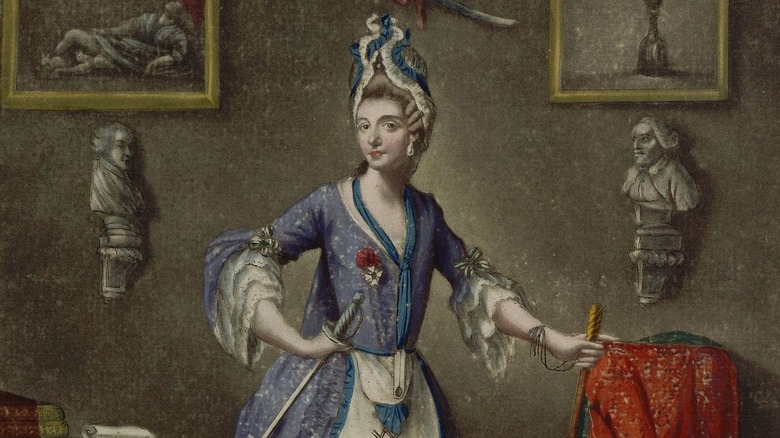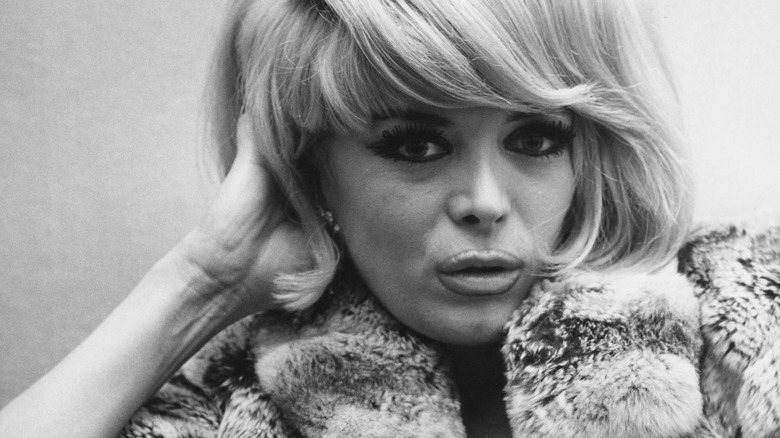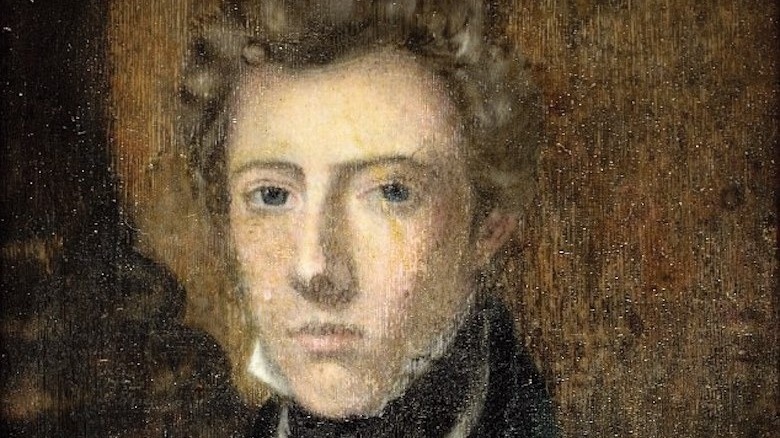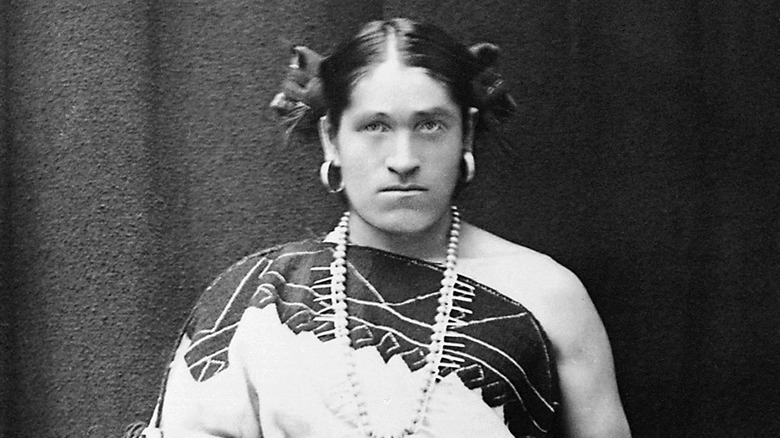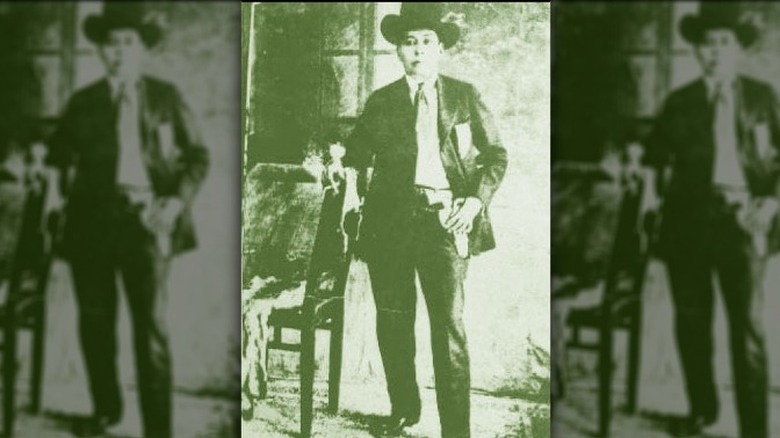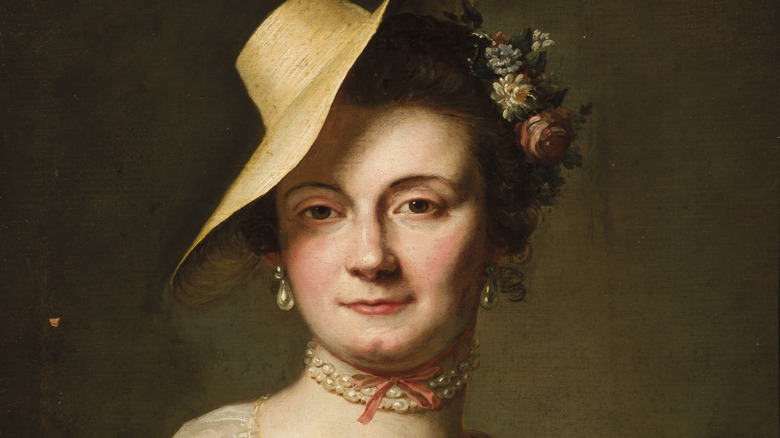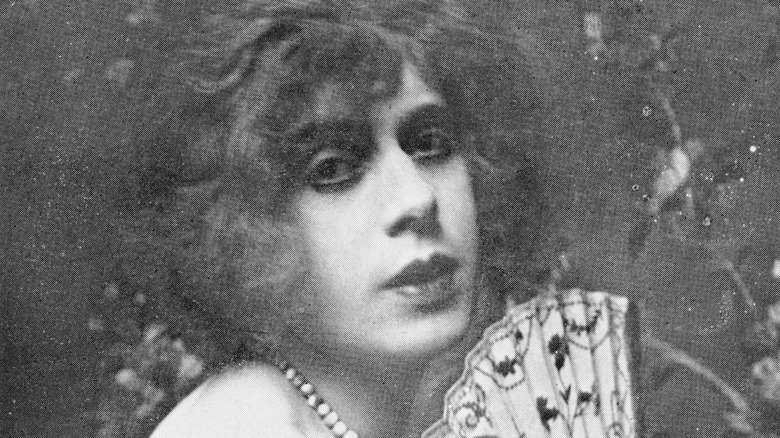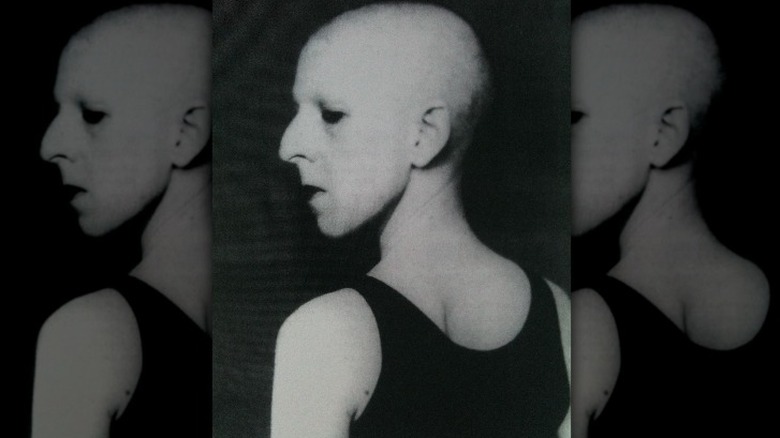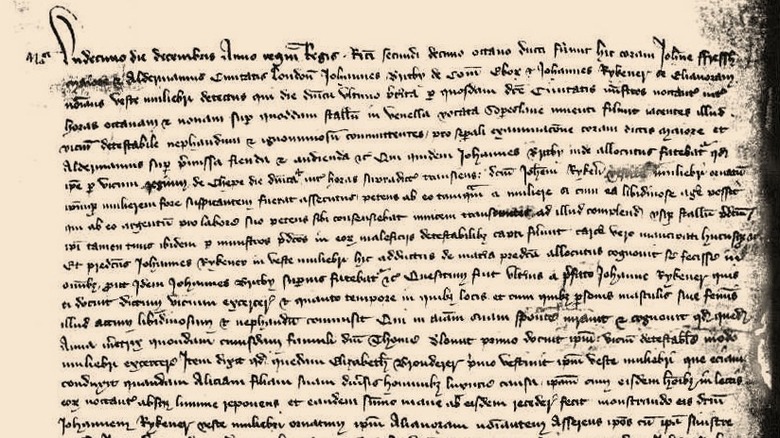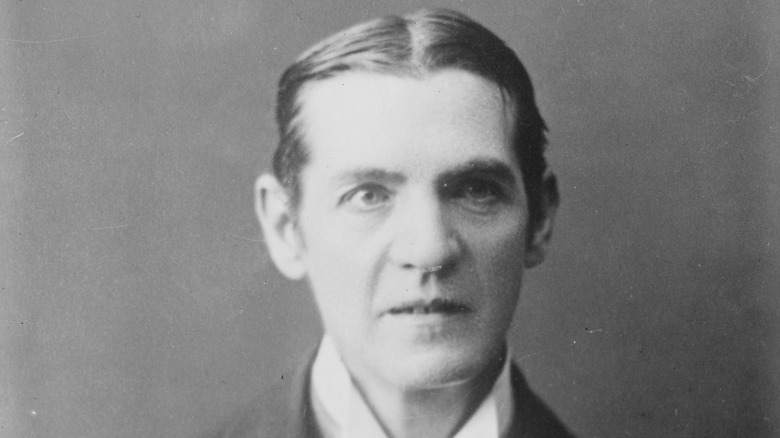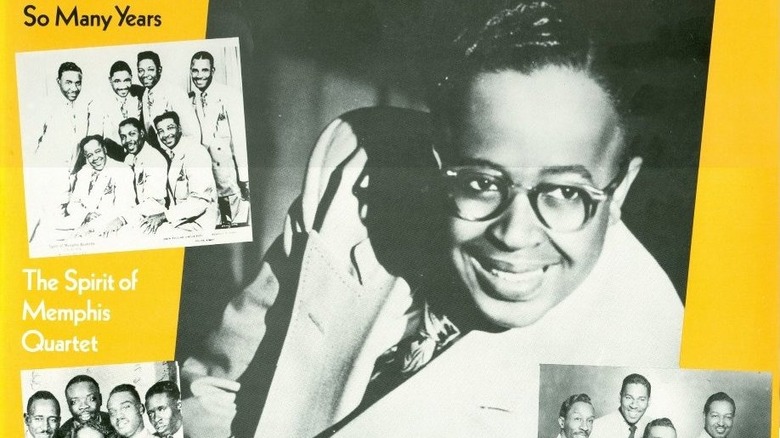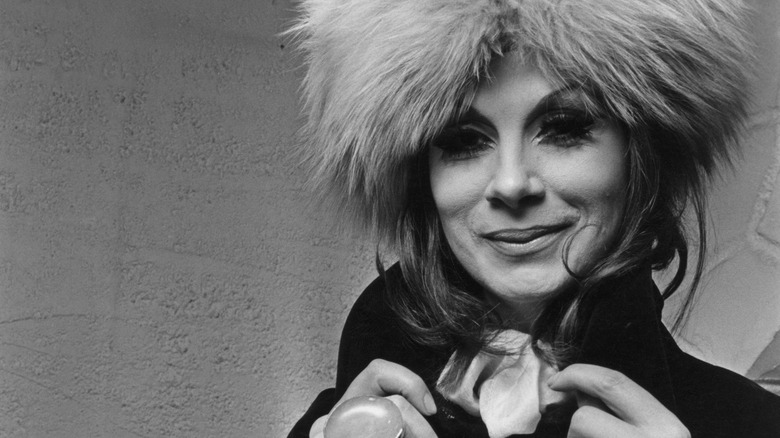Transgender History Makers They Didn't Teach You About In School
Trans people have always existed in society, although many have kept a low profile or been brushed under the rug of history. The word "transgender" was first used in the 1960s, but there are countless untold stories of trans and gender-nonconforming folk nonetheless. Of course, care needs to be taken, as modern language is not the same as that which historical figures used. Some may have lacked the language to fully describe their lived experiences, or use language we no longer recognize. All the same, people fitting the modern definition of transgender have lived worldwide, as far back as ancient Mesopotamia.
Unfortunately, many have gone unrecognized because numerous historical records have obscured trans people's identities, often due to prejudice, persecution, or simple ignorance. As a result, records of individual trans people from history are a little sparse, with only the most noteworthy people being remembered. One such prominent figure was Elagabalus, a controversial Emperor of Rome, infamous for lewd behavior. While generally recorded as a man, some accounts may suggest this ancient ruler may have been a trans woman. The book "Roman History" by the ancient historian Cassius Dio notes Elagabalus as saying, "Call me not Lord, for I am a Lady," and offering vast wealth to any doctor who could perform surgery to give Elagabalus a fully female body. While not all have been quite as ostentatious as Roman nobility, however, there have been many trans people in history, some of whom were quite remarkable.
Coccinelle
Jacqueline-Charlotte Dufresnoy was a famous actress in 20th-century France. She realized her trans identity when she was just four years old, later saying, "I knew I was different. I was a girl, really, but nobody could see it." Later, she became better known by the nickname of Coccinelle, meaning ladybug, a name that she earned while still a teenager for a black and red polka dot dress she wore. Using the same nickname as a stage name, she made her performance debut at the age of 22 and became wildly successful, with a blonde bombshell aesthetic modeled after big stars like Brigitte Bardot and Marilyn Monroe. Five years later, in 1958, she made history by becoming the first French person ever to undergo gender confirmation surgery.
Following news of her surgery, Coccinelle hit the big time herself, applauded by the press, and her cabaret show went on to tour around the world. Soon afterward, she appeared on the big screen, taking roles in movies in the 1960s. Coccinelle was also a talented vocalist, recording songs including an album entitled "Chercher la Femme."
Notably, while she wasn't an activist, her life became a revolutionary act in itself. In 1960, she married the journalist Francis Bonnet in a full Catholic church ceremony. Rebaptized as Jacqueline, and fully recognized as a woman under French law, Coccinelle made history by establishing both the legal and religious right for trans people to marry in France.
Dr. James Barry
James Barry was an esteemed military surgeon who earned one of the highest medical ranks in the British Army. He was also famously eccentric, known for challenging a fellow officer to a duel, getting on the wrong side of Florence Nightingale, and traveling with his own collection of animals. Serving in the military was a childhood ambition for Barry, and he enrolled at the age of 19, earning a medical degree by the age of 22. A skilled surgeon, he also stood up for equality, treating everyone regardless of rank or social status, and speaking out about poor conditions in prisons, asylums, and barracks.
Historically, James Barry has often been regarded as a deceiver, pretending to be a man, with many accounts referring to him as "the UK's first female doctor," but this is likely a gross misrepresentation of his identity. As the Science History Institute points out, James Barry perfectly fits the modern definition of a trans man. He lived his life exclusively as a man, both in public and private, and never considered himself a woman again after joining the military.
Barry's trans status was only discovered posthumously, though this was most certainly against his wishes. He'd previously made only a single request in the event of his death — that his body should remain unexamined and be buried in the same clothes he wore when he died. Had that wish been honored, he'd only ever have been remembered as a man.
We'wha
We'wha was a Native American and a member of the Zuni Tribe, who became a cultural ambassador and diplomat. They were also a Lhamana, a Zuni gender role outside the Western binary definitions, related to the better-known term Two Spirit. As Indian Country Today explains, Two Spirit people have been part of Native American cultures since time immemorial, long predating modern LGBTQ+ terminology, and widely misunderstood in the modern world.
As a lhamana, We'wha was neither male nor female, instead using a societal role as both to act as a mediator. Esteemed among the Zuni people, lhamanas play an important role, using their wisdom and unique perspective to keep society woven together. We'wha's identity was recognized at the age of three, and they went on to be a celebrated spiritual leader who worked hard to preserve Zuni cultural heritage, traditions, and history — particularly important during a time when Native cultures were being heavily oppressed by America's assimilation policies.
In the middle of a changing world, We'wha became a celebrity figure when they visited Washington D.C. in 1885, challenging stereotypes. This celebrity status was widely not positive though, exposing all the most racist and fetishistic tendencies of Western media, but their meeting with President Grover Cleveland also yielded an important result. In an effort to stop further harm to their people from missionaries and corrupt government agents, We'wha insisted that an agent be dispatched to the Zuni directly from Washington. A skilled negotiator, they convinced Cleveland to agree.
Lucy Hicks Anderson
Lucy Hicks Anderson didn't just live through America's prohibition era. She prospered through it as a pioneering Black business owner. Born in 1886, she was raised as a girl on advice from her family's doctor, after making her trans identity known. In the 1920s, she became a renowned chef and hostess, catering to wealthy families and throwing lavish parties, as well as donating generously to charities like the Red Cross.
Some of Anderson's businesses were less legal, however, including brothels and speakeasies. In the prohibition era, this was nothing unusual, and Anderson became widely known in her community for providing places where workers could relax. By the 1940s, she owned several businesses, balancing her legal and illicit life, and living between worlds afforded her some protection. The Smithsonian's Sidedoor Podcast recounts the story of how, on one occasion, she was arrested for running a speakeasy, but was immediately bailed out by a wealthy banker, alarmed that she otherwise wouldn't be able to cater for a dinner party he was planning.
Later in the 1940s, Lucy Hicks Anderson became one of the first Black trans women documented in US history, but this was not by choice. In 1945, a compulsory medical examination revealed her as a trans woman. At the time, US law didn't recognize trans women, so she was tried in court for being married to a man. Of course, she protested this vocally, stating, "I have lived, dressed, acted just what I am — a woman."
Amelio Robles Ávila
In 1912, Amelio Robles Ávila signed up to fight in the Mexican Revolution. From 1913 to 1918, he fought under the command of Mexico's most prominent revolutionary figures, becoming one of the most trusted and feared soldiers of Emilio Zapata himself, earning the rank of Zapatista Colonel. Joining the movement at the age of 23, Ávila's identity as a trans man was an open secret. He was a skilled horseman, an exceptional sharpshooter, and had a reputation for seducing women, making him well-respected enough that few were bold enough to deny his identity. As Mexico News Daily mentions, if any of his fellow soldiers did misgender him, he would aggressively correct them — sometimes at gunpoint.
Unlike the women who also fought in the Revolution, Ávila didn't simply take a man's name but lived his life exclusively as a man until his death at 95, altering his records to match his identity. As a child, his family ran a ranch and a mezcal distillery, and he had always preferred more stereotypically masculine pursuits, like marksmanship and lassoing cattle. Though he would later be a vocal socialist, his enrollment in the military was primarily a way to escape from the conservative attitudes of rural society, giving him a chance to express himself the way he wanted. However, his identity as a trans man remained mostly unrecognized by the public until relatively recently when, as an old man, he received an honor as a hero of the Mexican Revolution.
Chevalier d'Éon
The Chevalier d'Éon was one of the most enigmatic figures of the 18th century. Embroiled in scandal and subterfuge, they were a soldier, diplomat, and spy, who worked for one of history's first secret services. Described variously as either he or she in historical accounts, and shown androgynously in portraits, the Chevalier's true identity and gender remained elusive throughout their life.
The Chevalier's full name was Charles Geneviève Louis Auguste André Thimothée d'Eon de Beaumont — noteworthy for having six given names, three masculine and three feminine. At different times of their life, they lived openly as both a man and a woman, and used their genderfluidity to great advantage in espionage. On a mission to help France forge an alliance with Empress Elizabeth I of Russia, they disguised themself simultaneously as two different people; a brother and sister.
After falling from favor in France, the Chevalier d'Éon went to London as a political exile and published state secrets in the book "Lettres, mémoires et négociations." For their mystery and intrigue, they became a celebrity. Some in London began placing bets on what their "true" gender really was, sometimes reaching thousands of pounds — an exorbitant amount at the time. If anyone publicly challenged them on the matter, however, the Chevalier would challenge them to a duel in return. In modern language, the Chevalier is best described as genderfluid, and some suspect they may have been intersex.
Dr. Alan L. Hart
Alan L. Hart was an important figure in 20th-century medicine, developing pioneering treatments for tuberculosis. Tuberculosis at the time was a deadly disease because, by the time visible symptoms started to show, it was already in its late stages, making it difficult to treat. As a radiologist, Scientific American explains that Hart was the first to use X-rays to screen for tuberculosis early, helping to treat patients and prevent the infections from spreading. The same technique is still in use today.
Dr. Hart was a trans man, and his parents both fully supported his identity from an early age, letting him grow up as a boy. He was fully accepted as such too, despite having to register at school with his birth name. Hart went on to have a distinguished career, earning a Ph.D. and two master's degrees, as well as writing four novels. As a doctor, he could also access gender-affirming treatments, including having a hysterectomy, and later taking synthetic hormones soon after they first became available.
His own experience in a marginalized identity likely helped Hart to relate and show empathy to his patients, particularly those with a stigmatizing disease like tuberculosis. As well as providing treatments, he also spent much of his free time later in life fundraising, both to sponsor further medical research and to support patients unable to shoulder the financial burden of medical care.
Lili Elbe
In the late 19th century, Lili Elbe was a Danish artist who was known for post-impressionist paintings, with an eye for pastoral landscapes with soft palettes and tranquil scenery. She studied at the Royal Danish Academy of Fine Arts, where she met Gerda Gottlieb, the woman she would marry. Gottlieb was skilled as a painter and illustrator, particularly in the art deco style, and she would paint fashion portraits of Elbe dressed in fine clothing. Despite her initial hesitation, the clothing felt natural to Elbe, who later said, "I felt very much at home in them from the first moment." Eight years after the two were married, Lili Elbe was living exclusively as a woman, and they moved to the more accepting city of Paris.
Lili Elbe would become one of the first recipients of gender-affirming surgery. She had always been feminine and, per Thought Co, some believe she may have had Klinefelter Syndrome, an intersex condition where someone has three chromosomes, two X and one Y. With Elbe's medical records having been destroyed, though, there's no way to be certain of this. What is certain is that she enjoyed being able to live as herself more than anything, describing her tragically brief time post-surgery as "a whole and happy human life." Her real-life story was the inspiration for the novel and movie, "The Danish Girl."
[Featured image: Man into Woman, An Authentic Record of a Cha via Wellcome Collection | Cropped and scaled | CC BY 4.0]
Claude Cahun
Born in 1894, Claude Cahun was a French writer and artist who adopted a deliberately gender-neutral persona. She became best known as a surrealist self-portrait photographer, drawing inspiration from her 20th-century contemporaries like Man Ray and Salvador Dali. While she continued to refer to herself with feminine pronouns, Cahun was non-binary in modern terms, and when commenting on the matter, she once said, "Masculine? Feminine? It depends on the situation. Neuter is the only gender that always suits me."
In her artistic career, Cahun worked with her partner Marcel Moore, who also adopted a gender-neutral presentation. As step-siblings, they'd known each other from an early age, and later moved to Paris together. There, as MoMA explains, Cahun became inspired by the blossoming avant-garde movement and how it challenged social norms. Her art went on to explore themes of gender, pushing against stereotypes and keeping a running theme of ambiguity, both in her work and personal life.
Being from a Jewish family, Cahun's life was interrupted by rising fascism in 20th-century Europe. Cahun and Moore fled to Jersey in 1937, both joining an active resistance movement when the island was occupied by Germany, publishing leaflets to distribute to soldiers. Signed as "The Soldier with No Name," these were filled with seditious ideas in an attempt to incite mutiny. While Cahun was caught and sentenced to death for her actions, she managed to avoid this punishment and remained in Jersey for the rest of her life.
[Featured image by lightsgoingon via Wikimedia Commons | Cropped and scaled | CC BY-SA 2.0]
Eleanor Rykener
Eleanor Rykener may be the first English trans woman in recorded history, with her name preserved in legal documents from the 14th century. Applying modern terms to people from so long ago is something that must be done carefully, but all evidence suggests that Eleanor Rykener's experience was fully consistent with that of a trans woman. She lived her life exclusively as a woman, working as an embroideress and as a barmaid, two jobs which were exclusively taken by women at the time. She was also a sex worker, which was what got her in trouble with the law, though it's likely she was initially coerced into this profession.
Very little is known about Rykener and, had she not been arrested in 1395, it's likely there would be no surviving records of her life at all. Her arrest was in London, for performing a sex act, and all information about her comes from her following interrogation. While historians have mostly discussed her as a gay man, it's likely this is a mischaracterization. An essay in Modern Feminist Forum argues the case that she lived and was accepted as a woman in society, including referring to herself as Eleanor in a court of law, meaning that recognizing her as a trans woman is seemingly more accurate. Eleanor Rykener's name was preserved purely by a quirk of fate, but it's doubtful she was the only trans woman in Medieval England.
Thomas Baty/Irene Clyde
Born in 1869, Thomas Baty was a vocal gender nonconformist who described himself as a radical feminist. A genderfluid person, he went often wrote under the name of Irene Clyde, actively opposing constructed societal ideas of gender. The Bodleian Library mentions that he was also an avid student of law, earning a total of no less than four law degrees and a doctorate in civil law from Queens College London and Cambridge University.
In his personal life, Baty was a gender pioneer. Writing as Irene Clyde, he published extensive books and articles opposing the strictness of the gender binary. One of Clyde's notable books, "Beatrice the Sixteenth," was a work of utopian fiction about an explorer traveling to a genderless feminist society. Clyde's novel was published in 1909, laying the groundwork for ideas explored by later novels like "Orlando" by Virginia Woolfe, "The Left Hand of Darkness" by Ursula K. Le Guin, and "Ancillary Justice" by Anne Leckie.
Irene Clyde was also one of the founders of the journal Urania. Little remembered in the modern day, it was published between 1916 and 1940, and aimed to completely dismantle conventional ideas about gender. Clyde's co-founders were Eva Gore-Booth and Esther Roper, a pair of lesbian suffragists seen as rebels against acceptable society. Considering the idea of an inherent difference between genders to be a dangerous one, they sought to undermine it. With Urania, they were "determined to ignore the dual organization of humanity in all its manifestations."
Willmer Little Ax Broadnax
Willmer Broadnax, better known by his moniker of Little Ax, was a trans man and a celebrated gospel singer. Born in 1916, his musical career lasted for half a century, beginning with the Los Angeles Southern Gospel Singers, before later starting his own band. Working together with his brother, his band was known as Little Axe, based on his own nickname.
Little Ax was born in Houston, Texas, in 1916. Per Black Revolutionary Theatre Workshop, his family supported his trans identity, letting him grow up as a boy and, when he was 13, they wrote him into the U.S. census as male. He earned his nickname for being the shorter of the two brothers, with his younger brother being known as Big Ax. With a rich and soulful tenor voice, Little Ax went on to sing with a few other gospel groups, including the Fairfield Four, the Five Blind Boys of Mississippi, and the resoundingly popular Spirit of Memphis Quartet.
Unfortunately, Little Ax's career wouldn't last. When rock and roll started to gain popularity, the days of gospel music were numbered. Driven by stars like Chuck Berry, rock and roll took the world by storm as the gospel genre fell from favor, and Little Ax moved to Philadelphia with his brother, to retire. His status as a trans man remained completely unknown until after his death.
April Ashley
In their early lives, many trans women served in the military. In modern times, Chelsea Manning is one of the best-known, but in the early 20th century, April Ashley followed a similar path. Born in 1935, she enrolled in the British Navy as a teenager. It wasn't until later, after she was discharged, that she adopted a feminine name and became a stage performer, inspired by the Parisian actress Coccinelle. Motivated by seeing both Coccinelle and the American transgender actress Christine Jorgensen, Ashley underwent gender-affirming surgery in Morocco. The procedure was still new, but she used the "courage of desperation" as her motivation.
Following her surgery, she mentioned feeling "extraordinary happiness" and soon moved back to London, where she became a well-known socialite and a model. For a brief time, she was Vogue magazine's favorite underwear model until, in 1961, she was publicly outed by British tabloid newspapers.
Despite all the struggles she went through though, April Ashley persevered and became an outspoken LGBTQ+ icon. In 2005, at the age of 70, she finally received legal recognition of her gender and was issued with a new birth certificate. She would later receive an MBE for services to transgender equality in 2012, a lifetime achievement award in the 2014 European Diversity Awards, and an honorary doctorate in literature from the University of London in 2019, just two years before her death.
